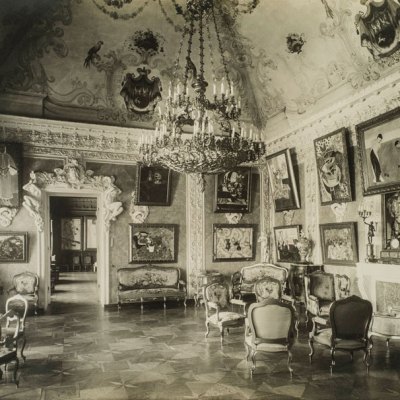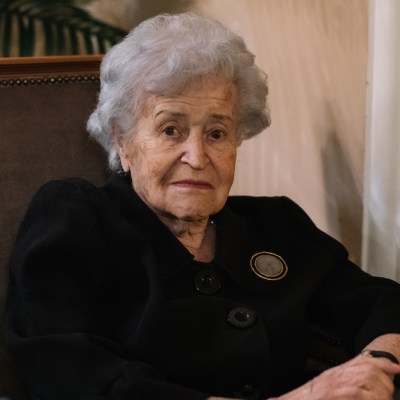At first glance, they might be identical. Two orange lozenges leaning out of shards of blue. Two paintings purportedly by the same artist. But look a little closer, and you’ll start to notice differences. The one on the left seems clunkier, its gradations in colour less subtle. The palette seems reduced, the brushwork less varied and interesting. The one on the right is Painterly Architectonic (1917) by Liubov Popova, a cubist and suprematist painter who lived a brief and active life in early 20th-century Moscow. The one on the left is a fake.
The paintings have been on show in ‘Russian Avant-Garde at the Museum Ludwig: Original and Fake – Questions, Research, Explanations’ (currently closed due to Covid-19 restrictions; due to run until 7 February 2021), an attempt by this museum in Cologne to answer questions about its collection. The field of the ‘Russian avant-garde’ – paintings made from the late 1890s through to the early 20th century – is especially prized by the art market; a painting by Kazimir Malevich, whose work is represented in the exhibition, sold for nearly $86m at Christie’s in 2018. The market is also rife with fakes. In the same year, an Israeli art dealer named Itzhak Zarug was convicted of falsifying provenance statements. Separately in 2018, an exhibition at the Museum of Fine Arts in Ghent closed when scholars questioned the authenticity of some of the show’s works. The Museum Ludwig, which was built in 1976 to display the private collection of the chocolate heirs Irene and Peter Ludwig, has been going through its paintings – a mix of Russian avant-garde, American Pop art, and Picassos – and examining them. This exhibition is a result of that action, and it is presented as an educational experience.
Supremus No. 38 (1916), Kazimir Malevich. Museum Ludwig, Cologne. Photo: Rheinisches Bildarchiv, Cologne

Much of the research done by the museum’s team looks specifically at the materials used to make the paintings. Synthetic fibres such as nylon and acrylic can be seen from microscopic specks, and make it easy to determine a painting’s age. One painting on display in the show, a canvas of dark swathes of paint, was once ascribed to Kliment Redko, a painter who briefly had a suprematist moment before turning to figurative work in 1923 (suprematism was a subset of avant-garde painting pioneered by Malevich, and focused on stark geometric forms). The back of the painting shows an inscription purportedly by Redko’s wife. ‘The work of my husband K. Redko 1922 Varying Composition (with extensive restorations… partial distortions c…[sic] 5 Oct. 1981, Redko.’ The first clue to the painting’s inauthenticity comes from the paint: one colour used is ‘titanium white’, an acrylic that first appeared on the market after the painting’s purported date. The canvas itself also had synthetic fibre in it: polyamide, available in the Soviet Union only from the 1930s onwards. Dealers made reference to a similar and more clearly provenanced painting in the Museum of Modern Art in Thessaloniki when selling to the Ludwigs. They argued that this proved the work’s authenticity. But that line of argument is dubious. In their research for the show, the curators found an image of the real painting in an art catalogue that more closely resembles the colours of the Ludwig collection’s work, suggesting that the artwork on display in Cologne was copied from the catalogue.
Suprematism (1921/22), previously attributed to Kliment Redko. Museum Ludwig, Cologne. Photo: Rheinisches Bildarchiv, Cologne

Pictures from the so-called Russian avant-garde movement have long appealed to Western tastes. As the critic Konstantin Akinsha explains in the exhibition catalogue, during the early Soviet era ‘diplomats willingly exchanged […] desired objects from the West, such as blue jeans, American LPs, and bottles of whiskey’ for painted pastiches. One collector described how fakes of Kandinsky’s paintings were so good they confused even his widow. A shift after the late 1960s from ‘Soviet’ to ‘Russian’ avant-garde helped sales by removing the whiff of radicalism from these works.
The sales of these frauds may have also changed the course of art history. One of the potent suggestions of the show is that the flood of ‘avant-garde’ art into the Western market created a school of art that existed only in the minds of Western collectors. One artist, Nina Kogan, may never have even existed. A gallery exhibit from 1985 stated that her works had been sent abroad by friends after her death. But little is known about the woman herself. The only fixed point was the fact that she starved to death in 1942 during the siege of Leningrad. What about a life and career before? Most of the images once attributed to her no longer carry her name. Who was she? Was she even a painter?
The curators of the exhibition refuse to say definitively that any of the paintings included in it are fake. Instead, each picture is accompanied by a series of clues, looking at, for example, the composition, style and craquelure. (This latter can be an unreliable clue, as the Russian avant-gardists anyway played with surface thickness and composition.)
‘We’ll never bring it to a conclusion,’ says curator Rita Kersting in a short video that plays in the exhibition hall. There may be legal reasons for her evasiveness. Galerie Gmurzynska, which sold hundreds of works to the museum – including some the Ludwig has now deemed falsely attributed as well as others shown to be real – filed a lawsuit demanding to see the research done for the exhibition in advance of its opening. The gallery’s owner told the New York Times that what she objected to was the use of the word ‘fake’ in the show’s title. The gallery’s claim was ultimately unsuccessful. In the same video, the head of the museum Yilmaz Dziewior stresses that part of the purpose of the exhibition is to teach visitors ‘how to look’.
When the video stopped playing, I attempted to do just this. I went upstairs to the museum’s permanent collection. In one nook were paintings by Malevich and Rodchenko. I tried to examine the craquelure on one of the paintings. It seemed thick and fissured. A sign of age? An indication of the avant-garde interest in surfaces? A sign of fakery? Or just something to be taken in and appreciated? The wall text gave little information aside from a name and a date. It occurred to me that the museum curators were now in the same position as everyone else – journalists, politicians, experts – for whom the default response in an age of information saturation and distortion must be scepticism. I stopped trying to reach a conclusion and walked back down the stairs, checking the news on my phone.
From the December 2020 issue of Apollo. Preview the current issue and subscribe here.


